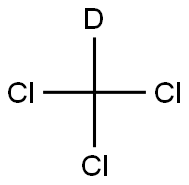A2334712
Chloroform-d , (D,99.8%)+1%V/VTMS , 865-49-6
Synonym(s):
Chloroform-D1;Deuterochloroform
CAS NO.:865-49-6
Empirical Formula: CCl3D
Molecular Weight: 120.38
MDL number: MFCD00000827
EINECS: 212-742-4
| Pack Size | Price | Stock | Quantity |
| 25G | RMB111.20 | In Stock |
|
| 50G | RMB199.20 | In Stock |
|
| 100G | RMB356.80 | In Stock |
|
| 500G | RMB1344.00 | In Stock |
|
| others | Enquire |
Update time: 2022-07-08
PRODUCT Properties
| Melting point: | −64 °C(lit.) |
| Melting point: | -63,5°C |
| Melting point: | -63,5°C |
| Boiling point: | 61-62°C |
| Boiling point: | 61-62°C |
| Boiling point: | 60.9 °C(lit.) |
| Density | 1.500 g/mL at 25 °C(lit.) |
| Density | d = 1,5 |
| Density | d = 1,5 |
| vapor pressure | 211 hPa (20 °C) |
| refractive index | n |
| Flash point: | 62°C |
| storage temp. | Store at +2°C to +8°C. |
| solubility | Miscible with organic solvents, ethyl acetate and acetone. |
| form | Liquid |
| color | White to beige |
| Specific Gravity | 1.505 |
| Water Solubility | 4.6g/L |
| Sensitive | Moisture Sensitive |
| BRN | 1697633 |
| Exposure limits | ACGIH: TWA 10 ppm OSHA: Ceiling 50 ppm(240 mg/m3) NIOSH: IDLH 500 ppm; STEL 2 ppm(9.78 mg/m3) |
| Stability: | Stable. Incompatible with strong bases, alkali metals, aluminium, magnesium, strong oxidizing agents. |
| InChIKey | HEDRZPFGACZZDS-MICDWDOJSA-N |
| LogP | 1.5-1.6 at 20-23℃ and pH9 |
| Surface tension | 72.3mN/m at 998.5mg/L and 20℃ |
| CAS DataBase Reference | 865-49-6(CAS DataBase Reference) |
| EPA Substance Registry System | Chloroform-d (865-49-6) |
Description and Uses
Deuterated chloroform (CDCl3), also known as chloroform-d, is an excellent everyday solvent choice for scientists who demand exceptional results. Commonly used as a solvent in proton NMR (1H NMR) spectroscopy, chloroform-d can dissolve a vast array of compounds with ease due to its weak polarity. It is often used in combination with methanol-d as a cosolvent. Plus, its low boiling point makes it relatively easy to recover a sample post-NMR analysis or during organic syntheses.
Chloroform-d may be used in the synthesis of dichlorofluoromethane-d (DCFM).
Safety
| Symbol(GHS) |   GHS06,GHS08 |
| Signal word | Danger |
| Hazard statements | H302-H315-H319-H331-H336-H351-H361d-H372 |
| Precautionary statements | P201-P301+P312-P302+P352-P304+P340+P311-P305+P351+P338-P308+P313 |
| Hazard Codes | Xn,T |
| Risk Statements | 22-38-40-48/20/22-48/20-36/38-20/22-63 |
| Safety Statements | 36/37 |
| RIDADR | UN 1888 6.1/PG 3 |
| WGK Germany | 2 |
| HazardClass | 6.1 |
| PackingGroup | III |
| HS Code | 28459000 |
| Toxicity | LD50 orally in Rabbit: 695 mg/kg LD50 dermal Rabbit > 3980 mg/kg |
| Limited Quantities | 5.0 L (1.3 gallons) (liquid) or 5.0 kg (11 lbs) (solid) |
| Excepted Quantities | Max Inner Pack (30g or 30ml) and Max Outer Pack (1Kg or 1L) |


